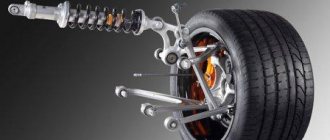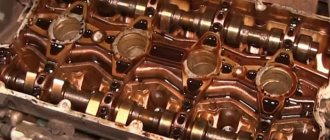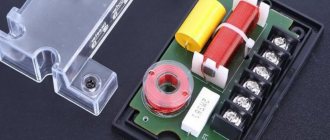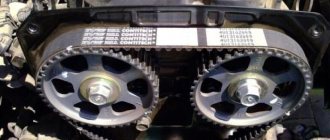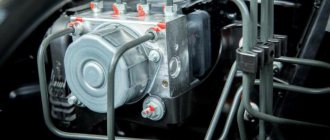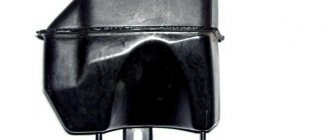I started the car in the evening and smelled something burning. The heater was turned on at first speed and when I started it, apparently all the energy was spent to start the engine, but the heater motor did not start. As a result, the heater heater resistor burned out. I turned on the 4th one, it works. And the stove fan works at 4 even without a resistor. Just don’t know why a turbo aircraft is needed at all)
The photo shows that the thermal fuse is located by bending it as close as possible to the heater resistor coil. If the resistor is heated to 117 degrees, its internal circuit melts and breaks. The same thing can happen when soldering a new one. But in fact, it burns out not from temperature, but from increasing current strength when the stove fan cannot move. When the fan cannot move, the load on this fuse increases to 17 amperes.
In fact, the resistor itself rarely burns out; the shiny part soldered to pin 4, called a thermal fuse, burns out. Such fuses are still installed in irons and refrigerators. And since this is a fuse, it’s very easy to check whether the resistor itself is working; take any piece of wire and try to short it with a “bridge”. That's exactly what I did. I turned the heater on to first, shorted it out, it works at all speeds. If it works, then it's the fuse. We go to the radio parts store (in Ufa “World of Electronics”) and buy a new one for 15 amperes 117 degrees for 25 rubles. Solder in a new fuse. When soldering, do not overheat, overheating more than 117 degrees will cause the fuse to fail!
You need to solder with a heat sink. Overheating will cause the part to become unusable. We put it in place under the glove compartment shelf. Voila, the stove works on all 4.
How else can you stir things up, for example, if this crap burned down on the road? We take a large plastic 20A auto fuse, tear apart the body, cut off the thermal fuse from the resistor so that then, by bending the antennae, you can crimp the terminals. Just don’t turn it on immediately without pushing it into place under the glove compartment, it will melt without blowing. And it works with airflow.
If you say that this is a collective farm version, then you can step it up like this, solder the mother terminals and insert a torn 20A fuse into the mother
The option of soldering in new fuses is the best. But they sell out quickly in electronics stores. I visited two stores. What do you think, where do the replaced resistors go in services? They sit and solder. Kalym!
Question for a guru in radio electronics.
What else can be soldered instead of this thermal fuse? Maybe a light bulb to illuminate the shelf? I also heard that in trucks, instead of this thermal fuse, there is a thermal relay or a reusable self-resetting thermal fuse. Curious about the part name? The Gazelle's heater resistor is very similar to ours, but it is three-pin and instead of a thermal fuse, some large black square piece is soldered in there. What kind of detail can be soldered into ours?
Today we will talk about a resistor, as the main element of any electrical circuit in a car. Why is it needed, what types of resistors are there, the principles of their operation, which ones are suitable for a particular electrical circuit.
This knowledge can be useful when repairing a car.
Why do you need a stove rheostat?
I started the car in the evening, started it, and smelled something burning. The heater was turned on at first speed and when I started it, apparently all the energy was spent to start the engine, but the heater motor did not start. As a result, the heater heater resistor burned out. I turned on the 4th one, it works. And the stove fan works at 4 even without a resistor. Just don’t know why a turbo aircraft is needed at all)
The photo shows that the thermal fuse is located by bending it as close as possible to the heater resistor coil. If the resistor is heated to 117 degrees, its internal circuit melts and breaks. The same thing can happen when soldering a new one. But in fact, it burns out not from temperature, but from increasing current strength when the stove fan cannot move. When the fan cannot move, the load on this fuse increases to 17 amperes.
removed resistor In fact, the resistor itself rarely burns out; the shiny part soldered to pin 4, called a thermal fuse, burns out. Such fuses are still installed in irons and refrigerators. And since this is a fuse, it’s very easy to check whether the resistor itself is working; take any piece of wire and try to short it with a “bridge”. That's exactly what I did. I turned the heater on to first, shorted it out, it works at all speeds. If it works, then it's the fuse. We go to the radio parts store (“World of Electronics” SAMARA on Fizkulturnaya Street) and buy a new one for 15 amperes 117 degrees for 25 rubles. Solder in a new fuse. When soldering, do not overheat, overheating more than 117 degrees will cause the fuse to fail! You need to solder with a heat sink. Overheating will cause the part to become unusable. We put it in place under the glove compartment shelf. Voila, the stove works on all 4.
Power dissipation
In addition to resistance, the resistor has another important parameter - power dissipation.
Any resistor acts as a kind of limiter and, due to its resistance, conducts only a certain voltage and current through itself. At the same time, the excess that it did not miss does not accumulate in itself, but converts it into thermal energy and dissipates it.
Therefore, resistors are designated by power dissipation.
Read also: Hypothesis in the introduction of design work
The discrepancy between this element and its dissipation power will lead to its overheating and destruction. Power dissipation is measured in Watts.
The power dissipation can be determined both by the voltage passing through it and by the current strength.
As for voltage, the formula for calculation looks like this:
- P – power;
- U – voltage in the circuit;
- R is the resistance of the resistor.
To calculate the current strength, the formula looks like this:
Visual inspection
Violation of the normal operating mode causes overheating of the part, therefore, in most cases, the problematic element can be identified by its appearance. This can be either a change in the color of the case or its complete or partial destruction. In such cases, it is necessary to replace the burnt element.
Figure 4. A clear example of how a resistor can burn out
Pay attention to the photo above, the component clearly needs to be replaced, while the neighboring parts “2” and “3” may be working, but they need to be checked.
Lighting
Recently, resistors have begun to be used in conjunction with LED lamps. This type of lamps has increasingly begun to be used on cars.
But not all cars yet come from the factory equipped with LED lighting devices, but it is quite possible to buy them separately and install them instead of standard incandescent lamps for the same turn signals or brake lights, and many do so.
But here a problem arises that requires the use of resistors.
The fact is that the electricity consumption of these lamps is very small, which is why the electronic unit regards the operation of the LEDs as a malfunction of the standard lamp.
To correct the situation, resistors are used to create a load on the wiring lines that power those lighting fixtures in which LED lamps are installed.
As a result, the ECU perceives the resistance of the element as the work of an incandescent lamp, so no error code occurs.
It is interesting that when using such decoys, the main advantage of LED lamps - low energy consumption - is reduced to zero, and they have only one advantage over conventional incandescent lamps - a long service life.
How to install a new stove
VAZ 2110 (10th family)
The standard ten stove is noticeably inferior to the new type stove: both in power and in ease of use. The process of installing a new stove is described in detail below. The result is more advanced heating in every sense.
New sample stove
It has a radiator n/o installed accordingly
Modernization of the cooling system “Kalinovsky style”!!
Maybe the rest of you should skip this point.
But since the steam outlet seems out of place for us now, we take it out and install this one instead
The one that was in the stove was replaced by agreement with the new one
Then we stomp to disassemble the car, remove the toad, wipers, Shumka, and we get this picture
Next we need to remove the left half of the stove (if you look at it from the face), here it awaits us
In the form of a bolt twisted from the interior, three more such ambushes await us when removing the right half of the stove, numbered 1, 2 and 3
2
3
For those who want to preserve the old stove in its entirety, there are two options, both hemorrhoids:
1. Remove the panel and then calmly unscrew these bolts from the interior.
2. Use a screwdriver to bend the mustache of the mortgages
Since I didn’t bother with the integrity of the stove, I just broke it off, and as a result we get this look
Next, we’ll halve the new heater to insert it, insert it and try it on, we see that it needs fastening to the body where there isn’t one, we mark the place where the fastener should be
We take a drill, drill, insert the embed, the fastening is ready
These holes shouldn't exist
Since I was not ready for this, I had to get out of it using improvised means:
From the body of an old stove
And glue it here
We find material to plug the other two holes, plug them (adhesive tape on top just in case)
We install the stove, look at the wiring connections
The wiring to the engine comes in one block
The old one sits on ground at one end, the other (+) goes through the block to the automatic control system, the output was bitten off from the engine of the old stove and the terminals were soldered to the new one (it’s better to buy the block in advance)
Extend the short wires to the resistance block that regulates the speed of the rotator
On the old stove the fuse module was three-pin, and on the new one it was 4-pin.
Accordingly, there are only three wires
It is necessary to throw another wire into the cabin to the SAUO, but for the system to work correctly, you need to move the white-red end to a free place, and put a new one in its place, this can be done either in the SAUO block, or in the stove block, I changed it near the stove there better access
To conduct a wire you need the wire itself and two mothers
Insert into the block
We stomp into the cabin, remove the self-propelled guns
We take out the 6-pin block from it
We insert our wire into the free socket
Insert the block into the automatic control system
Who has an old self-propelled gun system to fix the glitch with the damper, you need to swap the red and brown wires on the 13-terminal block, pins 2 and 8 (view from the face of the connector)
and there is no need to run a fourth wire.
Thanks for the information Kachan
We connect and secure the stove
We connect the terminal blocks to the damper
We fasten the stove near the right wing with pre-purchased fasteners
I didn’t have this, I made a homemade one from it. cap fasteners 8ki
We fasten in other places, on top is the one we made a little earlier
And two more fastening points at the bottom, on the studs with which the Shumka is attached
Let's go check the operation of the engine, check the dampers and make sure everything is working.
Next we connect the pipes, install the frill, Shumka, wipers and fill in antifreeze
As a result of the replacement, the following were damaged:
- The old frill crumbled to dust when removed;
- Shumka mounting stud — unscrewed together with the nut almost effortlessly (replaced with a self-tapping screw);
- Well, the old stove itself - may it rest in peace!
It has become noticeably warmer in the cabin, all speeds of the turntable are working
Cooling system
So, the load resistor is used in the car’s cooling system, or more precisely, in the radiator fan power circuit.
It is worth noting that previously this electrical element was not used in this circuit, and everything worked very simply - when a certain coolant temperature was reached, the temperature sensor closed the contacts of the fan power circuit, and it started working.
The use of a resistor made it possible to make the fan motor operate in two or even three modes.
The process of supplying power to the fan has changed somewhat. Relays have also been added to the system, and in modern cars the electronic control unit is already responsible for turning on the fan.
That is, the electronic unit analyzes the temperature readings of the sensor and sends a signal to the relay.
Depending on the temperature, the relay directs electricity through a specific circuit. If the coolant temperature is slightly exceeded, but it is already required to be reduced, and a signal from the ECU is received, the relay directs electricity through a load resistor, which creates resistance, and the fan begins to rotate at low speed.
If the temperature continues to rise and reaches a critical point, the relay will redirect the electricity through another circuit - bypassing the resistor, directly to the fan, which will ensure its operation at full power, with a high rotation speed.
This is a dual-mode fan operation circuit, which is ensured by the presence of a load resistor in the circuit. Moreover, it is simplified to make it more understandable.
In a car with three-mode fan operation, the principle remains the same, but it already uses two resistors - one is responsible for low fan speeds, the second for medium ones.
What tools should be used for diagnosis?
You can check the power supply to the engine connector with a regular test. But when carrying out full diagnostics and identifying faults of a high degree of complexity, a multimeter is needed. If you have knowledge of using a multimeter, you can easily measure the power on the connectors and check the resistance, which will make it possible to quickly troubleshoot wiring problems or identify problems with resistors.
In addition, measuring resistance and diagnosing wires in this mode will greatly facilitate the search for a short circuit.
You can diagnose PWM controllers for electrical systems that control fan speed using an oscilloscope. But purchasing this device for diagnostics is not advisable due to its high cost.
Isn’t it better to use the diagnostic methods listed below, which in most cases will help identify the sources of malfunctions in the stove fan without expensive equipment. So let's get started.
If it is impossible to start the fan , this situation occurs due to:
- worn brushes. When performing the functions of a conventional DC motor for a stove fan, the main problem is the abrasion of the brushes, with the help of which voltage is supplied to the commutator. With strong abrasion of the copper-graphite brushes, the pressing spring force that creates the contact is reduced, which in turn leads to the fan operating at a variable frequency. For example, it turns on when you hit the front panel or hit potholes in the road.
- faulty electrical control circuits. The source of the problem is contacts that have been sealed off due to strong heating;
- break in wires, oxidized contact;
- blown fuse element. If a fuse constantly blows (after replacing it), the technician must find a section of the circuit with a short circuit.
HOW THE OVEN FAN WORKS
The car interior heating fan is a conventional AC motor. This can be either a simple axial fan or a diametrical version, which is most often installed on modern cars. The design of the internal part of the stove fan is no different from that of a conventional AC electric motor excited by permanent magnets.
Of greater interest to us is the operation of the electric motor at different speeds. This possibility is realized by including additional resistance in the circuit. Resistors increase resistance, which leads to a decrease in current flowing in the circuit. Consequently, the fan begins to rotate more slowly. The value of the resistor determines how much current will drop in the circuit. The final fan speed is direct because there is no resistance included in the circuit. This allows the heater fan to remain operational even if the resistance has failed.
Marking of SMD elements
Surface-mounted components (for example, SMD resistor, diode, capacitor, etc.) began to be marked with numbers, but due to the small size of the parts, this information needed to be encrypted. For resistances, in most cases, a designation of three numbers is accepted, where the first two are the value, and the last is the multiplier (see Fig. 3).
Rice. 3. An example of decoding the value of an SMD resistor
Recycling
In recirculation mode, the main air damper closes, after which the heater fan begins to draw air from the passenger compartment. This mode of operation allows you to block the access of unpleasant odors and polluted air from the street if, for example, you are driving a car along a dusty gravel road.
In winter, the recirculation mode allows you to warm up the car interior faster, since not frosty air, but warm interior air passes through the heater radiator. Accordingly, in summer, recirculation makes it easier for the air conditioner to cool down.
Types of recirculation drive:
Validation check
If the part is soldered, then this stage will guarantee its functionality. For testing we need to know the denomination. How to identify it by markings was written above.
The algorithm of our actions is as follows:
- We connect the probes as in the previous testing.
- We turn on the resistance measurement (the range is shown in Figure 6) in a mode greater than the nominal value, but as close as possible to it. For example, we need to test a 47 kOhm resistor, therefore, we need to select the “200K” range.
Figure 6. Resistance measurement ranges (marked in red) - We touch the terminals with the probes, take readings and compare them with the nominal value. If they do not match, and this can be guaranteed with a probability close to 100%, do not despair. Both the error of the device and the tolerance of the element itself should be taken into account. A little clarification is necessary here.
Purpose
The main purpose of a resistor is to create resistance to be able to control and adjust the current and resistance. In fact, it is a kind of filter that allows you to obtain electricity with certain parameters at the output.
It provides all this by holding current, dividing and reducing voltage.
The main parameter of a resistor is the resistance it creates in the circuit, and it is measured in Ohms.
Resistors in the electrical circuit of a car.
It is precisely because of its function that this element is so often used in cars. Below we will look at some of the main components of a car, where a resistor is used and what specific function it performs there.
Three main components of electric current
Electricity has become an integral part of our lives. It is used almost everywhere, including in vehicles.
This type of energy has three main components - voltage, current and resistance.
As for the last parameter, due to the possibility of creating additional resistance at any point in the electrical circuit, you can influence the first two parameters.
The main element for creating resistance is a resistor. This element is one of the most in demand, and not a single electrical circuit can do without it, and it will not be possible to replace it with anything else. And in any car there are plenty of electrical circuits.
General air circulation diagram
Air is drawn into the car interior by a fan, which can be installed in the cabin or behind the engine shield. The cabin filter is located above the electric motor. If heating is necessary, the air flow passes through the heater radiator. The heater radiator is connected to the car's cooling system, so when the engine heats up, circulating fluid from the engine cooling system heats the heater radiator honeycomb. Therefore, passing through the honeycomb, the air flow also becomes warm.
When there is no need for heating, intake air purified by the filter is supplied to the cabin directly from the environment. If the car is equipped with air conditioning, in the cooling mode, the flow passes through the evaporator before entering the cabin, after which the cold air is directed into the deflectors (more about the principle of operation of the air conditioning system).
Air dampers
Redirection of air flows to regulate temperature is carried out by a special damper. Types of damper control:
- mechanical. The damper drive is connected directly to the switch in the cabin via rods and cables. In this case, the driver, by moving the regulator, manually doses the temperature of the incoming air;
- electronic. The damper is equipped with a servo drive. The electric motor changes the position of the damper, receiving commands from the control unit. This scheme is used on cars with climate control systems. The driver just needs to set the desired temperature in the cabin in the on-board computer, after which the electronic control unit, focusing on temperature sensors, will control the air damper servomotor.
Channels extend from the stove fan into the cabin, through which air can be supplied to the windshield, to the feet, or through the central deflectors. Depending on the operating scheme, the modes can be either combined or single, when all the intake air is supplied to only one zone. Switching modes can be done mechanically or using a servo drive and a control unit. The mechanical method involves direct connection of the air dampers to the switch on the dashboard. The electric drive of the dampers allows you to control them by pressing a key, as well as to implement automatic control of the electronic unit of the interior air conditioning system.
Recycling
In recirculation mode, the main air damper closes, after which the heater fan begins to draw air from the passenger compartment. This mode of operation allows you to block the access of unpleasant odors and polluted air from the street if, for example, you are driving a car along a dusty gravel road.
In winter, the recirculation mode allows you to warm up the car interior faster, since not frosty air, but warm interior air passes through the heater radiator. Accordingly, in summer, recirculation makes it easier for the air conditioner to cool down.
Types of recirculation drive:
Types of resistors, their features
Of the resistors described above that are used in the design of a car, two types can be noted - load, they are also constant and variable. In general, these are two main types that have fairly wide application in various fields.
Of course, there is a whole range of different resistors that differ in their design features. For example, thermistors, in which the resistance changes with temperature, or photoresistors, which change their parameters depending on the illumination. But we will not touch on them for now, but will consider only the two types indicated.
Fixed resistors are so called because the resistance they create is constant.
For example, if it is indicated that the main parameter of a given element is 30 Ohms, then it provides the resistance of exactly this value and it is impossible to change it.
In variable resistors, the resistance can be changed, manually. An example of this is the already mentioned control of the electric motor of the heating system.
Variable resistors also include trimmers.
In such resistors, you can also change the parameter manually, but its adjustment is not performed at any time, as is done in a variable one, but only when it is necessary to reconfigure the operation of the entire circuit in which it is included for a long period.
Trimmers are not used in vehicles, although they can often be found in household appliances.
Checking for a break
Actions are performed in the following order:
- We turn on the device in the “dialing” mode. In Figure 5 this position is marked as “1”.
Rice. 5. Setting the mode (1) and connecting probes (2 and 3) - We connect the probes to sockets “2” and “3” (see Fig. 5). Despite the fact that in our testing polarity does not matter, it is better to immediately train yourself to connect the probes correctly. Therefore, we connect the red wire (+) to socket “2”, and the black wire (-) to “3”.
If the model of the device you are using differs from the one shown in the figure, read the instructions that came with the multimeter.
- We touch the pins of the problematic element on the board with the probes. If the part “does not ring” (the multimeter will show the number 1, that is, an infinitely large resistance), we can state that the test showed a break in the resistor.
Please note that this testing can be carried out without desoldering the element from the board, but this does not guarantee a 100% result, since the tester can show communication through other components of the circuit.
Repair and restoration of the stove damper
The deformed heater damper of the VAZ-2110 cannot be repaired; it only needs to be replaced. In this case, it is better to purchase a replacement metal part that is not so susceptible to temperature effects.
Whatever heater is installed on the VAZ-2110, to carry out repair work, the heater must be completely disassembled. In this case, the process of dismantling and disassembling depends on the design of the stove.
A positive aspect of the heater design on the VAZ - 2101 is its location - to get to it and the dampers you can from the engine compartment and you don’t have to remove the front panel.
Disassembling an old-style stove
For example, let's look at how to disassemble an old-style heater:
- Remove the terminal from the battery.
- We remove the windshield wipers, the seal, remove the air intake near the windshield (“jabot”) from the car, in the process you will need to disconnect the windshield washer nozzle tubes.
- We dismantle the insulation that separates the stove body from the engine compartment.
- We remove the gear motor.
- We divide the housing of the stove and air filter into two halves. To do this, unscrew the coupling bolts around the perimeter of the housings and remove the mounting brackets.
- Disconnect the fan power wires.
- Remove the outer half of the air filter and heater housing (along with the fan).
- We dismantle the inner part of the fan housing.
After this you will have access to the dampers. If you are only planning to repair or replace the heater dampers, there is no need to drain the antifreeze, since the heater radiator will remain in place and will not be removed.
Before removing the dampers, carefully inspect and remember their position and the way they are engaged. Further actions depend on the nature of the damage. Deformed damper parts cannot be repaired and only need to be replaced. As for damaged rods and levers, try to repair them or simply replace them. The damaged seal is replaced.
When assembling the stove, pay special attention to the engagement of the dampers. Do it as it was before disassembly, otherwise the dampers will not work correctly, which will affect the performance of the heater
Disassembly and repair of a new type heater
The new model stoves are disassembled differently:
- disconnect the battery terminal, drain the antifreeze;
- dismantle the frill and insulation;
- disconnect the power wires of the fan and micromotor gearbox;
- unscrew the fasteners that secure the stove body to the body;
- disconnect the coolant supply pipes to the heater radiator;
- We remove the heater from the car along with the filter housing.
Do-it-yourself replacement of a VAZ-2110 heater resistor
In order to replace the resistor, it is important to understand where exactly it is located. The part is located on the right side of the stove behind the vacuum booster
The first step before starting work is to disconnect the battery from the power supply; to do this, remove the negative wire from the terminal.
Further work is carried out inside the car. Initially, it is necessary to dismantle the windshield trim and trim. After this, the soundproofing padding on the right side of the machine panel is removed. To gain good access to the converter, the vacuum booster must be removed.
An additional heater resistor came into view. Next, you should disconnect the block with wiring from the contacts of the converter. Remember exactly how it is connected so that you can reassemble it correctly when you are finished. The block can only be connected in one position.
Before you start replacing the product, you need to check its operation using an ohmmeter. There is no need to remove it to check the functionality of the part. Connect the contacts of the converter and ohmmeter in series, first on the first spiral, then on the second. If the resistance values differ significantly from the optimal value for the correct operation of the device, then the product must be replaced.
The main reasons for the failure of the stove fan
There are many more reasons for failure, they arise for a variety of reasons, we will look at the most basic causes of failure, which even an ordinary car enthusiast who is not involved in professional repairs can eliminate.
The stove brushes are worn out or damaged
In such a situation, you need to disassemble the stove motor and be sure to replace the brushes. To do this, the impeller wheel is removed from the electric motor housing (it is usually secured with latches). If the catalog of automobile spare parts does not contain the necessary brushes, then you can unsolder the old analogues and replace them with identical ones in size. As a last resort, graphite-copper brushes are filed using a needle file.
Speed control
In order to be able to control the speed of the heater fan, there is an additional resistor located behind the vacuum booster, on the side of the heater. It is equipped with two spirals: the 1st has a resistance of 0.23 Ohm and provides the lowest, 1st fan rotation speed. The second, at 0.82 Ohm, makes it possible to turn on the 2nd speed. If this part is working properly, the driver has the ability to control the temperature in the cabin, lowering it or raising it. If it fails, then there is only one speed left for the heater - the highest. It is the additional VAZ resistor that ensures their switching, except for the last one. Therefore, in fact, the highest one works if it breaks.






